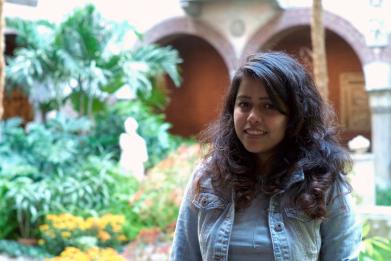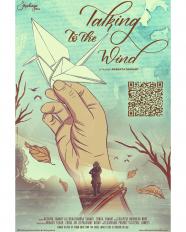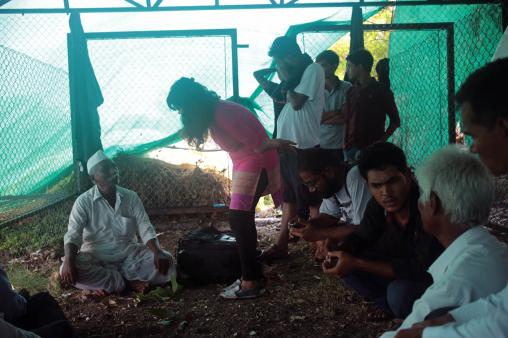Akshaya Sawant is a filmmaker from Mumbai, India. While she was studying Fine Arts during her undergraduate years, she started exploring photography because of the popularity of DSLRs. She created a stop-motion animation film in her final year that intrigued her to study filmmaking. After working as a wedding videographer and editor for a year and a half, she started applying for Masters programs overseas. She ended up at Emerson College in Boston and recently graduated with an MFA in Film and Media Art.
I spoke to her recently on her film, Talking To The Wind , a documentary on the Maharashtra drought.
What prompted you to make a film on the Maharashtra drought?
In spring 2016, in Boston after one of our class shoots, on our way to grab food, a friend of mine threw a gallon of fresh drinking water in trash. I got really upset and I voiced my concern; He told me that he didn't want to carry it because it was inconvenient. That's when I realized that there's a huge difference in the way resources are treated in United States as compared to a country like India. People in rural areas in India have to walk miles to bring a pot of water home, even more so during the drought. When I talked about this issue with my colleagues in USA, I realized that they were unaware about the drought and its adverse effects. That's when I decided to bridge the gap by making a film about the life and resilience of a small community in rural Maharashtra.
My uncle Rajaram Desai is the project manager at the Centre for Technology Alternatives in Rural Areas, IIT Bombay (CTARA) and works extensively to bring technological solutions to drought prone rural Maharashtra. This topic has always been a part of our discussions during family gatherings. When I decided to make the film, I reached out to him and he generously shared his research. He also told me that one of the main reasons behind the suicides is the dowry practice and the societal pressures of marrying their daughters. This was not just a shocking revelation to me but it served as a personal connection and a deeper purpose to tell the story.
Give us a synopsis of the film? where was it shot?
Since 2013, Maharashtra, India has been in the throes of a man-made drought which has surpassed the drought of 1972, a natural calamity. During the past three years of the drought, farmers have invested thousands of dollars in their crops, all in vain.
The societal norm in India, especially the rural areas, is a patriarchal system where the man goes to work and the woman stays home to take care of the house and children. To preserve her and her family’s honor in the society, the woman is married off as soon as she turns eighteen. The financial status of the family they marry depends on the dowry her parents can afford to give. Since bank loans are not easily accessible to them, farmers take money from private money lenders who charge exorbitant interest dowry. With no income because of the relentless drought, the farmers get drawn into a vicious debt cycle. In the communities of Maharashtra, a family’s honor is everything; not being able to provide for his wife and children destroys that honor. The farmers commit suicide because for them, it is the only way out. Since 2013, farmers are committing mass suicides - numbers reaching 1100 per year - the result of the conditions.
Intimate and eye-opening, Talking To The Wind explores the social and psychological effects of climate change as it impacts identity, the idea of masculinity, and the pressures of social structure.
The film was shot in small villages of Beed district of Maharashtra. We completed principal photography in June 2017 and I have been editing the film since. I completed the film in May 2019 and we are currently gearing up for festival submissions.
What challenges did you have while shooting this film?
Making this film was the biggest project that I had undertaken and that made every step challenging. I had never gone to shoot in a remote location leading a crew of 7 people, so there was a lot of uncertainty during every step. One of my cinematographers Cheng Jin, is Chinese and it was his first time in India! He struggled with the weather, water and food situation. He also had to deal with a lot of attention and racist remarks from the villagers who had never seen a foreigner before. But to his merit, he never complained and accepted these experiences with an open mind. We were also shooting in extreme weather conditions that the crew was not used to. I remember one such day when we were shooting in the field, which was not accessible by a vehicle and the temperature was soaring above 40 degree Celsius (104F). My line producer Kalpesh More and camera assistant Rajkumar Patil had to constantly bring us water because as soon as we drank the water, we would instantly sweat it out! That was the day I got sunburnt and most of us fell sick. But I am very grateful for a competent and resilient crew who were extremely supportive through every step of the way.
What was the reaction of the villagers?
In the beginning, the villagers thought that we were news reporters and would demand solutions for their problems. It would break my heart to tell them that I was just a student making a film but it also put the thought in my mind to somehow find a way to help these people, through this film. Overall, the villagers were very excited to see youngsters walking around with cameras and would welcome us to their homes with open hearts. Initially when I was looking for my subjects, I would go to every village and talk to the representatives. I remember one such evening when I went to Bhilegaon. I was surrounded by all the men from the village as I sat in the temple with my line producer Kalpesh More and sound recordist Sahishnu Tongaonkar. I can never forget that feeling! As we talked about the problems rooted in the community, I opened the topic of the status of women in their society and the dowry system. Everyone got very defensive and they told me that I don't belong there, I don't know what I am talking about and the dowry system would never go away. That conversation was eye-opening and made me understand the power dynamics in the community.
Earlier this year when I visited India, I went to the village to screen the film for the subjects. It was a quite a nerve-wrecking experience as they were going to watch their own life unfold through someone else's eyes. As the film progressed in the issues of gender inequality voiced by the members of their community, there was a shift in the audience's reaction. When the film ended, there was a long uncomfortable silence. The village leader stood in front of everyone and said that even though we may not like what's shown, we can't deny that it's the truth. His speech was followed by discussions on the gender bias in the community, starting a long overdue conversation.
What is the next plan of action ?
The plan of action is to have this screening experience on a larger scale. I want to start a traveling cinema initiative, screening this film accompanied by other animated, educational short films through untouched lanes of rural Maharashtra. These screenings will be followed by critical discussions on the state of women in the society. We will also have volunteers from 'The Red Elephant Foundation' who will teach them gender equality through games! The idea is to build a relationship with the villagers through entertainment, use the entertainment for education and awareness, followed by giving them tools to apply this knowledge in their lives. We have been following the dated rules are patriarchy that are deeply rooted in the older generation. But by teaching equality to the children and youth, we can empower the community and break the vicious cycle.
We currently have a crowdfunding campaign for the traveling cinema initiative. It's an "All of Nothing" campaign meaning if we don't reach our goal in the given time, we don't receive any funding i.e. your card will not be charged. We have 30 days left and are nowhere near our goal. Please check out the campaign and support in any way possible. Every dollar counts.
Support the cause: https://www.seedandspark.com/fund/talking-to-the-wind
Talking To The Wind Trailer: https://www.youtube.com/watch?v=cODbVwO1wLg&t=2s


